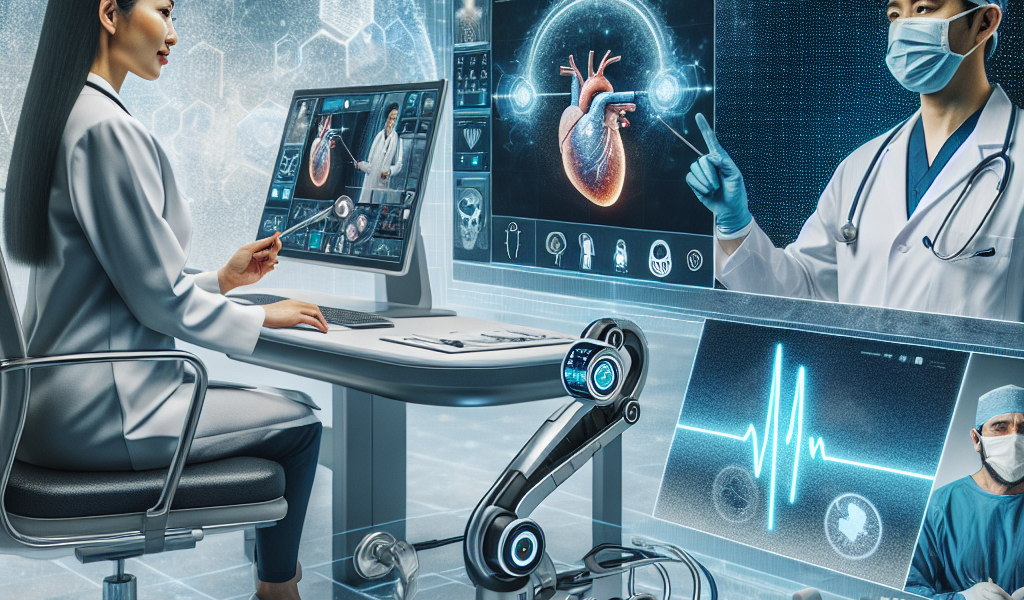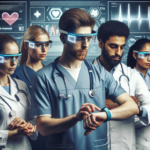-
Table of Contents
“Revolutionizing Care: The Future of Telemedicine and Healthcare Innovations”
Introduction

The Future of Telemedicine: Innovations in Healthcare
The rapid advancement of technology has revolutionized various sectors, and healthcare is no exception. Telemedicine, the practice of delivering medical care remotely using telecommunications technology, has emerged as a transformative force in the healthcare industry. This innovative approach not only enhances access to medical services but also improves the efficiency and quality of care. As we look to the future, telemedicine is poised to further evolve, driven by cutting-edge innovations such as artificial intelligence, wearable devices, and advanced data analytics. These advancements promise to address current challenges, expand the reach of healthcare services, and ultimately lead to better health outcomes for patients worldwide.
Advancements In Remote Patient Monitoring Technologies
The future of telemedicine is rapidly evolving, with advancements in remote patient monitoring technologies playing a pivotal role in transforming healthcare delivery. As the world becomes increasingly interconnected, the ability to monitor patients’ health remotely has emerged as a game-changer, offering numerous benefits for both patients and healthcare providers. This shift is driven by a combination of technological innovation, increased accessibility, and a growing demand for more efficient healthcare solutions.
One of the most significant advancements in remote patient monitoring is the development of wearable devices. These devices, ranging from smartwatches to more specialized medical sensors, allow for continuous tracking of vital signs such as heart rate, blood pressure, and glucose levels. The data collected by these wearables can be transmitted in real-time to healthcare providers, enabling them to monitor patients’ conditions closely and intervene promptly if necessary. This real-time data transmission is particularly beneficial for managing chronic diseases, where timely adjustments to treatment plans can significantly improve patient outcomes.
In addition to wearables, the integration of artificial intelligence (AI) and machine learning into remote patient monitoring systems has further enhanced their capabilities. AI algorithms can analyze vast amounts of data quickly and accurately, identifying patterns and trends that might be missed by human observers. This predictive analysis can help healthcare providers anticipate potential health issues before they become critical, allowing for proactive rather than reactive care. For instance, AI can predict the likelihood of a patient experiencing a cardiac event based on subtle changes in their monitored data, enabling early intervention and potentially saving lives.
Moreover, the advent of telemedicine platforms that incorporate remote patient monitoring has made healthcare more accessible to individuals in remote or underserved areas. These platforms facilitate virtual consultations, where patients can interact with healthcare providers without the need for physical travel. This is particularly advantageous for those with mobility issues or those living in rural areas where healthcare facilities may be scarce. By bridging the gap between patients and providers, telemedicine ensures that quality care is within reach for everyone, regardless of their geographical location.
Another noteworthy development is the use of remote monitoring technologies in post-operative care. Patients recovering from surgery can be monitored from the comfort of their homes, reducing the need for extended hospital stays and minimizing the risk of hospital-acquired infections. Remote monitoring devices can track patients’ recovery progress, ensuring that any complications are detected early and managed effectively. This not only enhances patient comfort but also alleviates the burden on healthcare facilities, allowing them to allocate resources more efficiently.
Furthermore, the integration of remote patient monitoring with electronic health records (EHRs) has streamlined the flow of information between patients and healthcare providers. EHRs provide a comprehensive view of a patient’s medical history, and when combined with real-time monitoring data, they offer a holistic picture of the patient’s health. This seamless integration facilitates better-informed decision-making and personalized care plans tailored to the individual needs of each patient.
As we look to the future, it is clear that remote patient monitoring technologies will continue to advance, driven by ongoing research and development. Innovations such as improved sensor accuracy, enhanced data security, and greater interoperability between devices and platforms will further solidify the role of telemedicine in modern healthcare. By embracing these advancements, we can look forward to a healthcare system that is more efficient, accessible, and responsive to the needs of patients worldwide.
The Role Of Artificial Intelligence In Telemedicine
The future of telemedicine is rapidly evolving, and at the heart of this transformation is the integration of artificial intelligence (AI). As healthcare systems worldwide grapple with increasing demands and limited resources, AI offers promising solutions to enhance the efficiency and effectiveness of telemedicine services. This technological synergy is not only reshaping patient care but also redefining the roles of healthcare professionals.
To begin with, AI’s ability to analyze vast amounts of data quickly and accurately is revolutionizing diagnostic processes. Traditional methods often require multiple tests and consultations, which can be time-consuming and costly. However, AI algorithms can sift through medical records, imaging results, and even genetic information to provide precise diagnoses in a fraction of the time. For instance, AI-powered tools can detect anomalies in medical images, such as X-rays or MRIs, with remarkable accuracy, often surpassing human capabilities. This not only speeds up the diagnostic process but also ensures that patients receive timely and appropriate treatment.
Moreover, AI is enhancing the personalization of telemedicine. By leveraging machine learning, AI systems can analyze individual patient data to tailor treatment plans that are specifically suited to their unique needs. This personalized approach is particularly beneficial for managing chronic conditions, where ongoing monitoring and adjustments are crucial. For example, AI can track a diabetic patient’s blood sugar levels in real-time, predict potential spikes or drops, and recommend dietary or medication adjustments accordingly. This level of customization was previously unattainable, but with AI, it is becoming a standard practice in telemedicine.
In addition to diagnostics and personalization, AI is also playing a pivotal role in streamlining administrative tasks within telemedicine. Scheduling appointments, managing patient records, and processing insurance claims are often labor-intensive and prone to human error. AI-driven systems can automate these processes, reducing the administrative burden on healthcare providers and allowing them to focus more on patient care. This automation not only improves efficiency but also enhances the overall patient experience by minimizing wait times and ensuring seamless interactions.
Furthermore, AI is facilitating remote patient monitoring, a cornerstone of telemedicine. Wearable devices equipped with AI capabilities can continuously monitor vital signs such as heart rate, blood pressure, and oxygen levels. These devices can alert healthcare providers to any concerning changes, enabling prompt intervention. For patients, this means greater peace of mind and a reduced need for frequent in-person visits. For healthcare providers, it means the ability to manage larger patient populations more effectively.
However, the integration of AI in telemedicine is not without its challenges. Concerns about data privacy and security are paramount, as sensitive patient information is increasingly stored and analyzed digitally. Ensuring that AI systems are transparent and free from biases is also critical to maintaining trust in these technologies. Addressing these issues requires robust regulatory frameworks and ongoing collaboration between technology developers, healthcare providers, and policymakers.
Despite these challenges, the potential benefits of AI in telemedicine are undeniable. As AI continues to advance, its applications in telemedicine will likely expand, offering even more innovative solutions to improve patient care. The future of telemedicine, powered by AI, promises a more efficient, personalized, and accessible healthcare system for all. As we navigate this exciting frontier, it is essential to embrace these technological advancements while remaining vigilant about the ethical and practical implications they entail.
Virtual Reality And Augmented Reality In Medical Training And Consultations
The Future of Telemedicine: Innovations in Healthcare
Virtual reality (VR) and augmented reality (AR) are no longer confined to the realms of gaming and entertainment. These cutting-edge technologies are making significant strides in the field of telemedicine, revolutionizing medical training and consultations. As healthcare systems worldwide grapple with the challenges of accessibility and efficiency, VR and AR offer promising solutions that could reshape the landscape of medical practice.
To begin with, VR and AR are transforming medical training by providing immersive, hands-on experiences that traditional methods simply cannot match. Medical students and professionals can now practice complex procedures in a risk-free, virtual environment. For instance, VR simulations allow aspiring surgeons to perform intricate operations, honing their skills without the fear of causing harm to real patients. This not only enhances their proficiency but also builds their confidence, ultimately leading to better patient outcomes.
Moreover, AR is being utilized to overlay digital information onto the physical world, offering real-time guidance during medical procedures. Surgeons can wear AR glasses that display critical data, such as patient vitals and anatomical structures, directly in their line of sight. This seamless integration of digital information with the physical environment can significantly improve precision and reduce the likelihood of errors. Consequently, AR is becoming an invaluable tool in the operating room, enhancing the capabilities of even the most experienced surgeons.
Transitioning from training to consultations, VR and AR are also making waves in patient care. Telemedicine has already broken down geographical barriers, allowing patients to consult with specialists from the comfort of their homes. However, VR and AR take this a step further by creating more interactive and engaging consultation experiences. For example, VR can transport patients to a virtual clinic where they can interact with their healthcare providers in a more personal and immersive manner. This can be particularly beneficial for patients with mobility issues or those living in remote areas, ensuring they receive the care they need without the hassle of travel.
In addition, AR can enhance remote consultations by providing doctors with a more comprehensive view of the patient’s condition. Through AR-enabled devices, doctors can visualize 3D models of a patient’s anatomy, making it easier to diagnose and explain medical conditions. This not only improves the accuracy of diagnoses but also helps patients better understand their health, fostering a more collaborative doctor-patient relationship.
Furthermore, the integration of VR and AR in telemedicine is paving the way for innovative therapeutic interventions. For instance, VR therapy is being used to treat mental health conditions such as anxiety, PTSD, and phobias. Patients can be gradually exposed to their fears in a controlled virtual environment, helping them build resilience and cope with their conditions more effectively. Similarly, AR is being employed in physical rehabilitation, where patients can follow guided exercises overlaid onto their real-world surroundings, making therapy sessions more engaging and effective.
As we look to the future, the potential of VR and AR in telemedicine is boundless. These technologies are not only enhancing the quality of medical training and consultations but also making healthcare more accessible and personalized. While there are challenges to overcome, such as ensuring data security and managing costs, the benefits far outweigh the drawbacks. With continued innovation and investment, VR and AR are set to become integral components of telemedicine, ushering in a new era of healthcare that is both advanced and compassionate.
Conclusion
The future of telemedicine is poised for significant advancements, driven by innovations in technology, increased accessibility, and evolving healthcare needs. With the integration of artificial intelligence, remote monitoring, and enhanced data security, telemedicine is set to revolutionize patient care by providing more personalized, efficient, and cost-effective solutions. As healthcare systems continue to adapt to these changes, telemedicine will play a crucial role in improving health outcomes, reducing disparities, and ensuring that quality care is accessible to all, regardless of geographic location.





